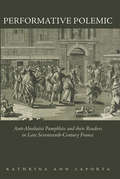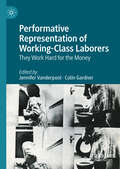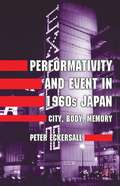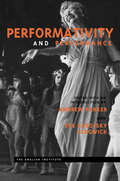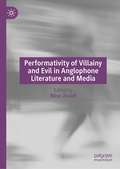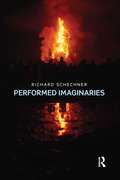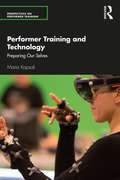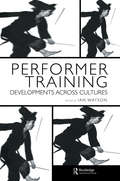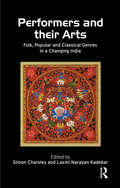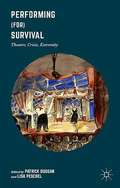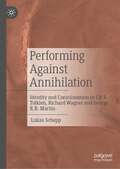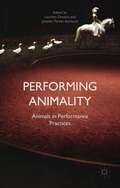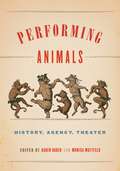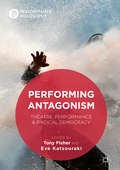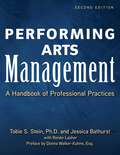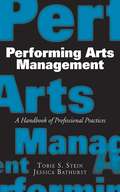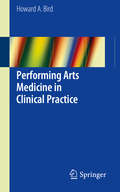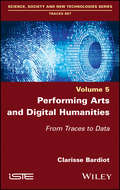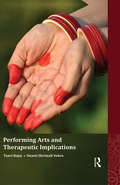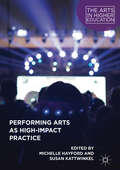- Table View
- List View
Performative Language Learning with Refugees and Migrants: Embodied Research and Practice in the Sorgente Project (Routledge Research in Language Education)
by Erika Piazzoli Fiona DalzielThis book investigates the use of performative language pedagogy in working with refugees and migrants, exploring performative language teaching as the application of drama, music, dance and storytelling to second language acquisition.Documenting a community-based project – funded by the Irish Research Council and conducted with three groups of refugees and migrants in Ireland and Italy – the book explores the methodological, pedagogical and ethical elements of performative language learning in the context of migration. Written by a team of arts-based researchers and practitioners, chapters discuss findings from the project that relate to factors such as embodied research methods, a motivation to belong and the ethical imagination, while exhibiting how performative language pedagogy can be effective in supporting children and adults in a range of challenging contexts.Offering a poetic and pictorial representation of the Sorgente Project, this book will be of interest to postgraduate students, researchers and academics in the fields of English language arts and literacy education, drama in education, the sociology of education and second language acquisition more broadly. Those working in refugee and migrant studies, and teacher education studies will also find the volume of use.
Performative Polemic: Anti-Absolutist Pamphlets and their Readers in Late Seventeenth-Century France (The Early Modern Exchange)
by Kathrina Ann LaPortaPerformative Polemic is the first literary historical study to analyze the “war of words” unleashed in the pamphlets denouncing Louis XIV’s absolute monarchy between 1667 and 1715. As conflict erupted between the French ruler and his political enemies, pamphlet writers across Europe penned scathing assaults on the his bellicose impulses and expansionist policies. This book investigates how pamphlet writers challenged the monarchy’s monopoly over the performance of sovereignty by contesting the very mechanisms through which the crown legitimized its authority at home and abroad. Author Kathrina LaPorta offers a new conceptual framework for reading pamphlets as political interventions, asserting that an analysis of the pamphlet’s form is crucial to understanding how pamphleteers seduced readers by capitalizing on existing markets in literature, legal writing, and journalism. Pamphlet writers appealed to the theater-going public that would have been attending plays by Molière and Racine, as well as to readers of historical novels and periodicals. Pamphleteers entertained readers as they attacked the performative circuitry behind the curtain of monarchy.
Performative Representation of Working-Class Laborers: They Work Hard for the Money
by Colin Gardner Jennifer VanderpoolPerformative Representation of Working-Class Laborers: They Work Hard for the Money is a transdisciplinary anthology intersecting art theory praxis, comparative literature, film & media studies, performance art, ethnic studies, gender studies, age & aging, geography, and labor studies. The book investigates and analyzes artwork created by artists or collectives working within the dialogue of Postmodernism and current global arts production. The focus on performative aspect of labor as art and affect becomes more sensate and less about the exploited body of labourers, liberating the representation of waged bodies and further diversifying the field of Working-Class Studies.
Performativity and Event in 1960s Japan: City, Body, Memory
by Peter EckersallTaking performance as a key word, this book explores important Japanese artists and art works in the 1960s in relation to the formation of postwar Japan. In response to the social upheavals of the 1960s, Eckersall shows how art interacted with society in unique and transformational ways. He includes case studies of rarely discussed artists and performances by Zero Jigen, Ichiyanagi Toshi, Iimura Takahiko and the contemporary group Port B, as well as dynamic cultural events such as the 1964 Olympic Games, mass protests and the 1970 Osaka Expo. A unique aspect of Eckersall's study is his interdisciplinary approach, which draws on Japanese writing on the 1960s in tandem with performance theory. By interweaving arguments about the critical role of performance as an artistic medium and as a social dramaturgy, this book will be of interest to scholars and students of contemporary Japanese society and culture, cultural historians and people interested in theatre and performance studies.
Performativity and Performance (Essays from the English Institute)
by Andrew Parker Eve Kosofsky SedgwickFrom the age of Aristotle to the age of AIDS, writers, thinkers, performers and activists have wresteled with what "performance" is all about. At the same moment, "performativity"--a new concept in language theory--has become a ubiquitous term in literary studies. This volume grapples with the nature of these two key terms whose traces can be found everywhere: in the theatre, in the streets, in philosophy, in questions of race and gender, and in the sentences we speak.
Performativity of Villainy and Evil in Anglophone Literature and Media
by Nizar ZouidiPerformativity of Villainy and Evil in Anglophone Literature and Media studies the performative nature of evil characters, acts and emotions across intersecting genres, disciplines and historical eras. This collection brings together scholars and artists with different institutional standings, cultural backgrounds and (inter)disciplinary interests with the aim of energizing the ongoing discussion of the generic and thematic issues related to the representation of villainy and evil in literature and media. The volume covers medieval literature to contemporary literature and also examines important aspects of evil in literature such as social and political identity, the gothic and systemic evil practices. In addition to literature, the book considers examples of villainy in film, TV and media, revealing that performance, performative control and maneuverability are the common characteristics of villains across the different literary and filmic genres and eras studied in the volume.
Performed Imaginaries
by Richard SchechnerIn this collection of essays, performance studies scholar and artist Richard Schechner brings his unique perspective to bear upon some of the key themes of society in the 21st century. Schechner connects the avantgarde and terror, the counter-cultural movement of the 1960s/70s and the Occupy movement; self-wounding art, popular culture, and ritual; the Ramlila cycle play of India and the way imagination structures reality; the corporate world and conservative artists. Schechner asks artists to redeploy Nehru's Third World as a movement not of nations but of like-minded culture workers who must propose counter-performances to war, violence, and the globalized corporate empire. With characteristic brio, Schechner urges us to play for keeps. "Playing deeply is a way of finding and embodying new knowledge", he writes. Performed Imaginaries ranges through some of the key moves within Schechner’s oeuvre, and challenges today’s experimental artists, activists, and scholars to generate a new, third world of performance.
Performer Training and Technology: Preparing Our Selves (Perspectives on Performer Training)
by Maria KapsaliPerformer Training and Technology employs philosophical approaches to technology, including postphenomenology and Heidegger’s thinking, to examine the way technology manifests, influences and becomes used in performer training discourse and practice. The book offers in-depth discussions of present and past performer training practices through a lens that has never been applied before; considers the employment of key digital artefacts; and develops a series of analytical tools that can be useful in scholarly and practical explorations. An array of intriguing subjects are covered including the role of electric lights in Stanislavsky’s work on concentration; the use of handheld tools, such as sticks in Zarrilli’s psychophysical training and Meyerhold’s Biomechanics; the emergence of new forms of training in relation to motion capture technology; and the way the mobile phone complicates notions and practices of attention in learning and training contexts. This book is of vital relevance to performer training scholars and practitioners; theatre, performance, and dance scholars and students; and especially those interested in philosophies of technology.
Performer Training: Developments Across Cultures (Contemporary Theatre Studies #Vol. 38)
by Ian WatsonPerformer Training is an examination of how actors are trained in different cultures. Beginning with studies of mainstream training in countries such as Poland, Australia, Germany, and the United States, subsequent studies survey: · Some of Asia's traditional training methods and recent experiments in performer training · Eugenio Barba's training methods · Jerzy Grotowski's most recent investigations · The Japanese American NOHO companies attempts at integrating Kyogen into the works of Samuel Beckett · Descriptions of the training methods developed by Tadashi Suzuki and Anne Bogart at their Saratoga International Theatre Institute · Recent efforts to re-examine the role and scope of training, like Britain's International Workshop Festival and the European League of Institutes of Arts masterclasses · The reformulation of the use of emotions in performer training known as Alba Emoting.
Performers and Their Arts: Folk, Popular and Classical Genres in a Changing India
by Simon CharsleyIntroduction Part I: Caste, Community and performance A ritual performance of Kerala, Vayala Vasudevan PillaiThe Patuas of Bengal, Makbul IslamBards and goddesses: The Pombalas in Tirupati, Anand AkundyExplorations in the art forms of the Cindu madigas in Andhra, Y A Sudhakar Reddy and R R HarischandraCaste identity and performance in a fisher-village of Assam, Kishore BhattacharjeePart II: Performance Beyond CasteTelugu pady natakam in Andhra: Performance dynamics, P SubbacharyModernising tradition: The yaksagana in Karnataka, Guru Rao BapatKalarippayatt as aesthetics and the politics of invisibility in Kerala, P K SasidharanIndia People’s Theatre Association in colonial Andhra, V RamakrishnaGaddar and the politics and pain of singing, D Venkat RaoReviving moghal tamsa in Orissa, Sachi MohantyPart III: Classical Dance and its SuccessorsNew directions in Indian dance, Sunil KothariTranspositions in kuchipudi dance, Aruna BhikshuThe impact of commercialization in dance, K Subadra MurthyArt addressing social problems, Ananda Shankar Jayant
Performing (for) Survival: Theatre, Crisis, Extremity
by Lisa Peschel Patrick DugganThis volume gathers contributions from a range of international scholars and geopolitical contexts to explore why people organise themselves into performance communities in sites of crisis and how performance – social and aesthetic, sanctioned and underground – is employed as a mechanism for survival. The chapters treat a wide range of what can be considered 'survival', ranging from sheer physical survival, to the survival of a social group with its own unique culture and values, to the survival of the very possibility of agency and dissent. Performance as a form of political resistance and protest plays a large part in many of the essays, but performance does more than that: it enables societies in crisis to continue to define themselves. By maintaining identities that are based on their own chosen affiliations and not defined solely in opposition to their oppressors, individuals and groups prepare themselves for a post-crisis future by keeping alive their own notions of who they are and who they hope to be.
Performing (for) Survival: Theatre, Crisis, Extremity
by Lisa Peschel Patrick DugganThis volume gathers contributions from a range of international scholars and geopolitical contexts to explore why people organise themselves into performance communities in sites of crisis and how performance – social and aesthetic, sanctioned and underground – is employed as a mechanism for survival. The chapters treat a wide range of what can be considered 'survival', ranging from sheer physical survival, to the survival of a social group with its own unique culture and values, to the survival of the very possibility of agency and dissent. Performance as a form of political resistance and protest plays a large part in many of the essays, but performance does more than that: it enables societies in crisis to continue to define themselves. By maintaining identities that are based on their own chosen affiliations and not defined solely in opposition to their oppressors, individuals and groups prepare themselves for a post-crisis future by keeping alive their own notions of who they are and who they hope to be.
Performing Against Annihilation: Identity and Consciousness in J.R.R. Tolkien, Richard Wagner and George R.R. Martin
by Lukas ScheppThis book outlines how the protagonists in The Nibelung's Ring, The Lord of the Rings, and Game of Thrones attempt to construct identities and expand their consciousness manifestations. As the characters in the three works face the ends of their respective worlds, they must find answers to their mortality, and to the threat it implies: the loss of identity and consciousness. Moreover, it details how this process is depicted performatively. In a hands-on and interdisciplinary approach, this book seeks to unveil the underlying philosophical concepts of identity and consciousness in the three works as they are represented audio-visually on stage and screen. Through the use of many practical examples, this book offers both academic scholars and any interested readers a completely new perspective on three enduringly popular and interrelated works.
Performing Animality
by Jennifer Parker-Starbuck Lourdes OrozcoPerforming Animality provides theoretical and creative interventions into the presence of the animal and ideas of animality in performance. Animals have always played a part in human performance practices. Maintaining a crucial role in many communities' cultural traditions, animal-human encounters have been key in the development of performance. Similarly, performance including both living animals and/or representations of animals provides the context for encounters in which issues of power, human subjectivity and otherness are explored. Crucially, however, the inclusion of animals in performance also offers an opportunity to investigate ethical and moral assumptions about human and non-human animals. This book offers a historical and theoretical exploration of animal presence in performance by looking at the concept of animality and how it has developed in theatre and performance practices from the eighteenth century to today. Furthermore, it points to shifts in political, cultural, and ethical animal-human relations emerging within the context of animality and performance.
Performing Animals: History, Agency, Theater (Animalibus)
by Karen Raber Monica MattfeldFrom bears on the Renaissance stage to the equine pageantry of the nineteenth-century hunt, animals have been used in human-orchestrated entertainments throughout history. The essays in this volume present an array of case studies that inspire new ways of interpreting animal performance and the role of animal agency in the performing relationship.In exploring the human-animal relationship from the early modern period to the nineteenth century, Performing Animals questions what it means for an animal to “perform,” examines how conceptions of this relationship have evolved over time, and explores whether and how human understanding of performance is changed by an animal’s presence. The contributors discuss the role of animals in venues as varied as medieval plays, natural histories, dissections, and banquets, and they raise provocative questions about animals’ agency. In so doing, they demonstrate the innovative potential of thinking beyond the boundaries of the present in order to dismantle the barriers that have traditionally divided human from animal.From fleas to warhorses to animals that “perform” even after death, this delightfully varied volume brings together examples of animals made to “act” in ways that challenge obvious notions of performance. The result is an eye-opening exploration of human-animal relationships and identity that will appeal greatly to scholars and students of animal studies, performance studies, and posthuman studies.In addition to the editors, the contributors are Todd Andrew Borlik, Pia F. Cuneo, Kim Marra, Richard Nash, Sarah E. Parker, Rob Wakeman, Kari Weil, and Jessica Wolfe.
Performing Animals: History, Agency, Theater (Animalibus: Of Animals and Cultures #11)
by Karen Raber Monica MattfeldFrom bears on the Renaissance stage to the equine pageantry of the nineteenth-century hunt, animals have been used in human-orchestrated entertainments throughout history. The essays in this volume present an array of case studies that inspire new ways of interpreting animal performance and the role of animal agency in the performing relationship.In exploring the human-animal relationship from the early modern period to the nineteenth century, Performing Animals questions what it means for an animal to “perform,” examines how conceptions or this relationship have evolved over time, and explores whether and how human understanding of performance is changed by an animal’s presence. The contributors discuss the role of animals in venues as varied as medieval plays, natural histories, dissections, and banquets, and they raise provocative questions about animals’ agency. In so doing, they demonstrate the innovative potential of thinking beyond the boundaries of the present in order to dismantle the barriers that have traditionally divided human from animal.From fleas to warhorses to animals that “perform” even after death, this delightfully varied volume brings together examples of animals made to “act” in ways that challenge obvious notions of performance. The result is an eye-opening exploration of human-animal relationships and identity that will appeal greatly to scholars and students of animal studies, performance studies, and posthuman studies.In addition to the editors, the contributors are Todd Andrew Borlik, Pia F. Cuneo, Kim Marra, Richard Nash, Sarah E. Parker, Rob Wakeman, Kari Weil, and Jessica Wolfe.
Performing Antagonism
by Tony Fisher Eve KatsourakiThis book combines performance analysis with contemporary political philosophy to advance new ways of understanding both political performance and the performativity of the politics of the street. Our times are pre-eminently political times and have drawn radical responses from many theatre and performance practitioners. However, a decade of conflict in the Middle East and Afghanistan, the eruption of new social movements around the world, the growth of anti-capitalist and anti-globalisation struggles, the upsurge of protests against the blockades of neoliberalism, and the rising tide of dissent and anger against corporate power, with its exorbitant social costs, have left theatre and performance scholarship confronting something of a dilemma: how to theorize the political antagonisms of our day? Drawing on the resources of 'post-Marxist' political thinkers such as Chantal Mouffe and Jacques Rancière, the book explores how new theoretical horizons have been made available for performance analysis.
Performing Arts Center Management (Routledge Research in the Creative and Cultural Industries)
by Patricia Dewey Lambert Robyn WilliamsPerforming arts centers (PACs) are an integral part of the cultural and creative industries, significantly influencing the cultural, social, and economic vitality of communities around the world. Virtually all PACs are community-based and serve the public interest, whether structured as a public, nonprofit, for-profit, or hybrid entity. However, there is a lack of knowledge about the important community role of performing arts centers, especially those that mainly host and present work produced by other arts organizations. This gap is startling, given the ubiquitous presence of PACs in urban centers, small communities, as well as colleges and universities. This co-edited reference book provides valuable information at the intersection of theory and practice in the professional field of executive leadership of performing arts centers. Drawing on the expertise of leading academics, consultants, and executives, this book focuses on institutions and practices in the United States, and is contextualized within additional fields such as cultural planning, urban revitalization, and economic development. Performing Arts Center Management aims to provide valuable theoretical, conceptual, empirical, and practice-based information to current and future leaders in creative and cultural industries management. It serves as a unique reference for researchers, university students, civic leaders, urban planners, public venue managers, and arts administrators aspiring to improve or advance their work in successfully managing performing arts centers.
Performing Arts Management (Second Edition): A Handbook of Professional Practices
by Tobie S. Stein Jessica Rae Bathurst Renee LasherDo you know what it takes to manage a performing arts organization today? In this revised second edition of the comprehensive guide, more than 100 managers of top nonprofit and commercial venues share their winning strategies.From theater to classical music, from opera to dance, every type of organization is included, with information on how each one is structured, key managerial figures, its best-practices for financial management, how it handles labor relations, and more.Kennedy Center, the Brooklyn Academy of Music, Lincoln Center, the Mark Morris Dance Company, the New Victory Theater, the Roundabout Theater, the Guthrie Theater, Steppenwolf Theater Company, and many other top groups are represented.Learn to manage a performing arts group successfully in today&’s rapidly changing cultural environment with Performing Arts Management.
Performing Arts Management: A Handbook of Professional Practices
by Tobie S. Stein Jessica BathurstDo you know what it takes to manage a performing arts organization today? In this comprehensive volume, more than 100 managers of top nonprofit and commercial venues share their winning strategies.* Financial management, building a funding base, labor relations, much more* Explores the realities of running a performing arts organization todayFrom theater to classical music, from opera to dance, every type of organization is included, with information on how each one is structured, key managerial figures, its best-practices for financial management, how it handles labor relations, and more. Kennedy Center, the Brooklyn Academy of Music, Lincoln Center, the Mark Morris Dance Company, the New Victory Theater, the Roundabout Theater, the Guthrie Theater, Steppenwolf Theater Company, and many other top groups are represented. Learn to manage a performing arts group successfully in today's rapidly changing cultural environment with Performing Arts Management.
Performing Arts Medicine in Clinical Practice
by Howard A. BirdFor many general practitioners, physiotherapists, osteopaths and chiropracters, patients with a background in performing arts account for only a small proportion of their practice. This simple primer assists the reader in the management of these highly complex (and sometimes highly strung) elite athletes. This book is pitched at the Masters level. A first degree in a medical speciality is assumed so space has not been allocated to the standard management of common conditions such as epicondylitis, carpal tunnel syndrome, ankle sprains of fractures. With some thirty years practical experience around the theme of "Controversies in Performing Arts Medicine", the editor has provided occupational rheumatological care for performing artists, especially instrumentalists and dancers with complex ailments. The introductory section provides a basic insight into the musculoskeletal problems specific to each of the many varied instruments and styles of dance. Consideration is also given to musculoskeletal aspects that affect the voice.
Performing Arts and Digital Humanities: From Traces to Data
by Clarisse BardiotDigital traces, whether digitized (programs, notebooks, drawings, etc.) or born digital (emails, websites, video recordings, etc.), constitute a major challenge for the memory of the ephemeral performing arts.Digital technology transforms traces into data and, in doing so, opens them up to manipulation. This paradigm shift calls for a renewal of methodologies for writing the history of theater today, analyzing works and their creative process, and preserving performances. At the crossroads of performing arts studies, the history, digital humanities, conservation and archiving, these methodologies allow us to take into account what is generally dismissed, namely, digital traces that are considered too complex, too numerous, too fragile, of dubious authenticity, etc.With the analysis of Merce Cunningham’s digital traces as a guideline, and through many other examples, this book is intended for researchers and archivists, as well as artists and cultural institutions.
Performing Arts and Therapeutic Implications
by Tanvi Bajaj Swasti Shrimali VohraPresenting an alternative perspective, this book proposes that performing arts forge an emotional bond between the performer and the audience, making the act of performance a therapeutic and restorative experience, and not merely recreational. Studying the life-experiences of six artists, and their unique engagement with three art forms — music, drama and dance — the book highlights the physical, emotional, mental, and spiritual effects of performing arts both on the performers and the audience. More importantly, it takes the current understanding of the therapeutic role of arts beyond a deficit model of health that focuses on their use in curing illnesses, disabilities and imbalances, towards a more positive growth-centric model that relates them to promoting holistic mental health, well-being and happiness. It thus bridges the gap between the theoretical understanding of creative arts therapy and the practical experience of performing arts in non-therapeutic settings. Further, it assumes increasing relevance with respect to fast-changing lifestyles to which stress and ill-health are often attributed. The book will appeal to artists, educators and researchers of performing arts, applied psychology, counselling and therapy, and cultural studies, as well as interested general readers.
Performing Arts as High-Impact Practice (The\arts In Higher Education Ser.)
by Michelle Hayford Susan KattwinkelThis book investigates how the performing arts in higher education nationally contribute to the “high impact practices,” as identified by the Association of American Colleges and Universities (AACU). Using the well-known map of the HIPs for illustrating the centrality of performing arts practices in higher education, the editors and authors of this volume call for increased participation by performing arts programs in general education and campus initiatives, with specific case studies as a guide. Performing arts contribute to the efforts of their institution in delivering a strong liberal arts education that uniquely serves students to meet the careers of the future. This is the first book to explicitly link the performing arts to the HIPs, and will result in the implementation of best practices to better meet the educational needs of students. At stake is the viability of performing arts programs to continue to serve students in their pursuit of a liberal arts education.
Performing Arts in Transition: Moving between Media (Routledge Advances in Theatre & Performance Studies)
by Susanne Foellmer Maria Katharina Schmidt Cornelia SchmitzArtists especially from dance and performance art as well as opera are involved to an increasing degree in the transfer between different media, not only in their productions but also the events, materials, and documents that surround them. At the same time, the focus on that which remains has become central to any discussion of performance. Performing Arts in Transition explores what takes place in the moments of transition from one medium to another, and from the live performance to that which "survives" it. Case studies from a broad range of interdisciplinary scholars address phenomena such as: The dynamics of transfer between the performing and visual arts. The philosophy and terminologies of transitioning between media. Narratives and counternarratives in historical re-creations. The status of chronology and the document in art scholarship. This is an essential contribution to a vibrant, multidisciplinary and international field of research emerging at the intersections of performance, visual arts, and media studies.

